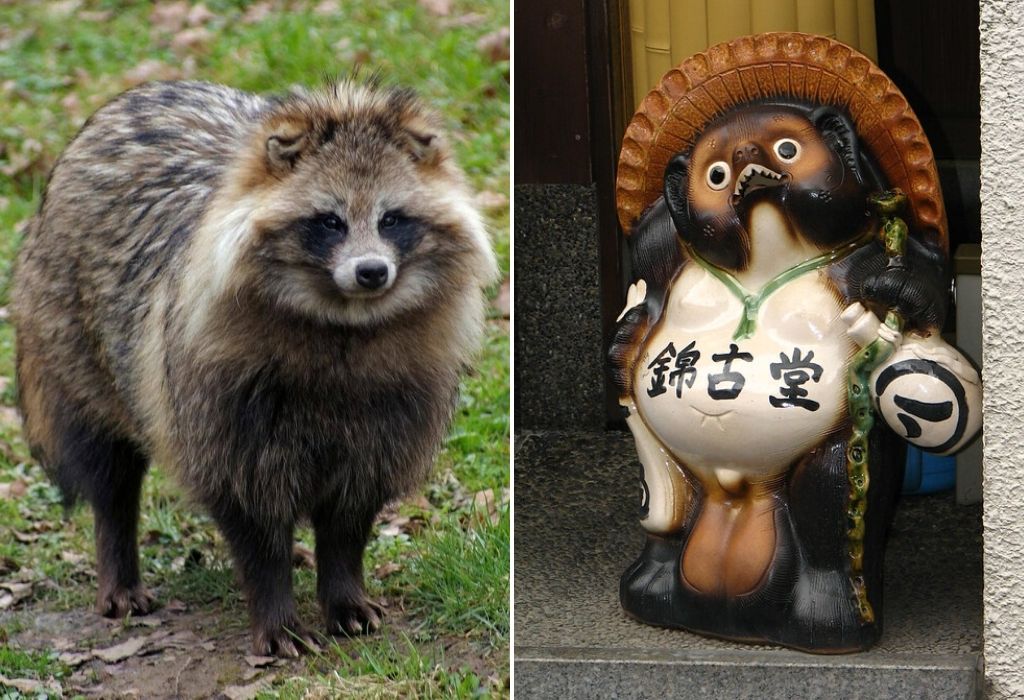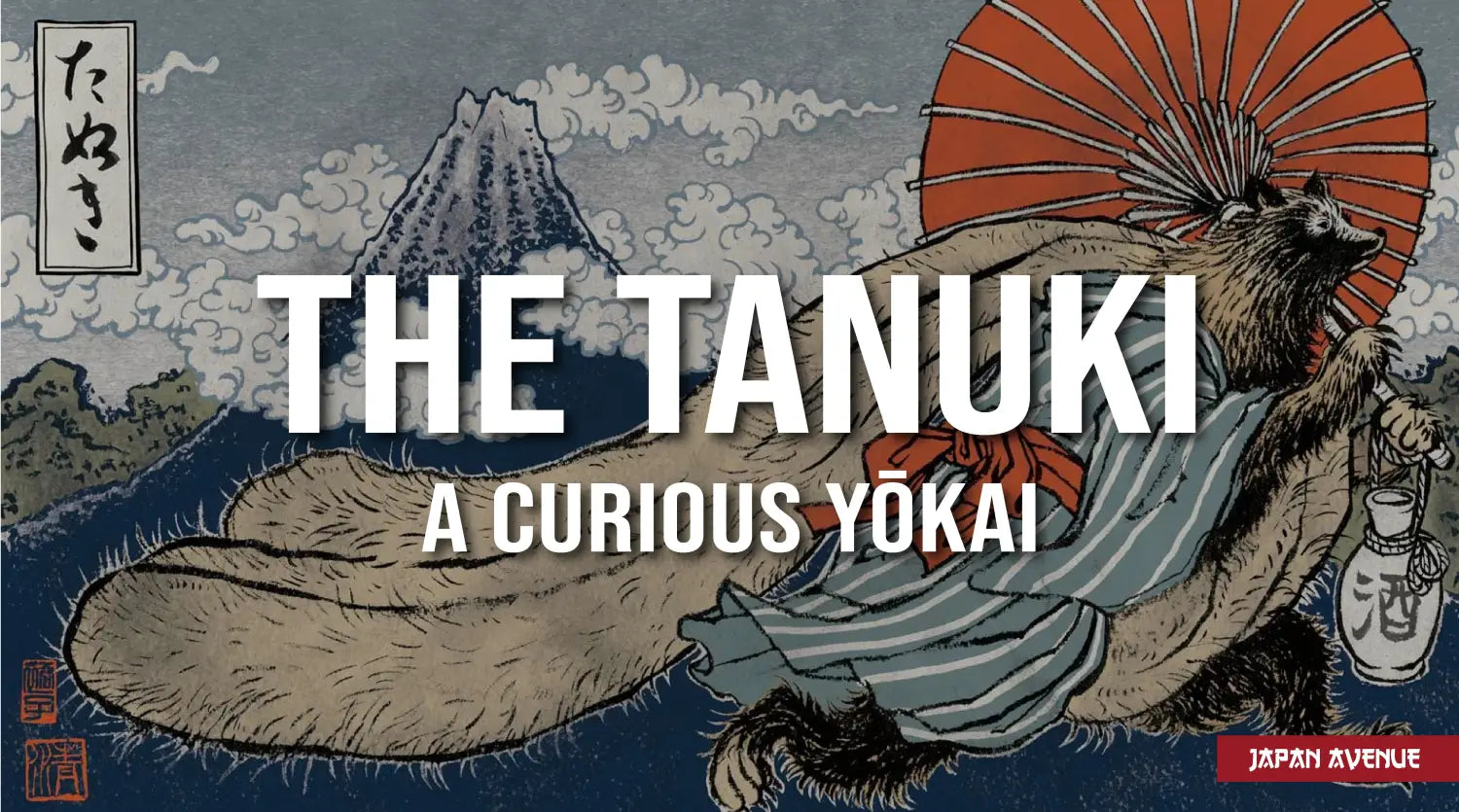Have you ever heard about the Tanuki? With its atypical look and its comical air, this yōkai is very much popular in Japan. Funny face, bouncy belly, straw hat and a bottle of sake; who on earth is this strange creature? 🤔
The term tanuki (タヌキ) refers to the Japanese raccoon dog, a subspecies of the Asian raccoon dog. In Japanese folklore, the Tanuki is considered a yōkai, a forest spirit with disproportionate attributes and magical powers.
First made famous by Isao Takahata's anime movie Pompoko, the Tanuki is a somewhat intriguing character. But what's behind this curious animal? What are its magical powers and its legends? Lastly, what does the Tanuki represent within Japanese culture?
👉 Let's take a closer look at this mysterious yōkai.
🐾 The Tanuki, a curious animal
Have you ever seen a Tanuki statuette in a restaurant, an Asian store, or in a manga? Its appearance has undoubtedly caught your attention! Indeed, it is impossible to remain indifferent in front of its raccoon head, its large round eyes, its big belly and its prominent male attributes 😆. Behind its good-natured looks, the Tanuki is part of the mysterious creatures or invisible spirits called yōkai in Japanese mythology.

Photo of a raccoon dog / Tanuki statue, Kyoto. ©Dev Kumar(Flickr)
Its name means "raccoon dog" in Japanese, a canid species 🐺 native to Asia that lives in mountains and forests. Of omnivorous nature, this animal mainly goes out at night in search of food. It can be recognized by its long hair and characteristic facial mask. The Tanuki has the particularity to hibernate. Besides, it is regularly mistaken for a raccoon or a badger.
In Japanese mythology, the raccoon dog has magical powers. Also called bake danuki, this forest spirit has the particularity to transform itself at will in order to fool men just like its sidekick, Kitsune, the magical fox. Known for its large scrotum and its love for sake, the Tanuki is a source of jokes for Japanese people.
🐕 The surprising origins of the Tanuki
This forest dog was first mentioned in the Nihon Shoki, a historical collection about the origins of Japan, dating from 720. The Tanuki also appeared on ancient medieval illustrated scrolls along with other yōkai such as the demon Tengu.
Popularized by Buddhist tales, the Tanuki became deeply embedded in Japanese folklore throughout the centuries. This mischievous creature, a bit of an airhead and particularly clumsy, is not afraid of transforming itself to play tricks on humans.
Depending on the legends and regions, this yōkai can be considered benevolent or hostile. In some stories, he may even go as far as killing in order to get what he wants. However, the Tanuki is no longer considered dangerous today, but more of a prankster and trickster.

Representations of Tanuki by Utagawa Kuniyoshi.
Evolution of the Tanuki
It seems that the appearance of this yōkai has largely evolved over the centuries. The representation of this animal with its giant pair of testicles dates back to the Edo period. In fact, the flexible skin of the tanuki's testicles was used to wrap gold inside when making gold leaf. This particularity inspired the famous myth of the family jewels that could be stretched up to 8 tatami mats if not 1000!
During the Edo period, the legends around the Tanuki developed. Moreover, the ukyo-e current projected the yōkai on the forefront by exploiting its inflatable scrotum in multiple situations. Thus, many artists like Utagawa Kuniyoshi divert this particularity to the extreme. We can thus observe Tanuki in numerous prints and comic illustrations carrying their testicles in a bundle or using them as an umbrella, for example...

Tanuki wood carving / Shigaraki pottery (Shiga prefecture)
The sake gourd and straw hat with which he is represented nowadays, appeared during the 20th century thanks to the statues of a famous Shigaraki potter.
💥 The magical powers of the Tanuki
Like most Japanese mythical creatures, the Tanuki has celestial powers. As a shape-shifting creature, It can transform and take on any appearance desired, such as that of an object or a human. Moreover, he perfectly masters the art of disguise. His paunchy belly serves him as a drum 🥁. In the imagination of the Japanese, the sound produced resembles the " pompoko ", a noise that inspired the film by Isao Takahata.

iImage extracted from the Japanese anime movie Pompoko directed by Isao Takahata for studio Ghibli.
Yet, the Tanuki is best known for its large size balls with multiple functions. He uses them as a weapon, a tool, an umbrella or even as a fishing net depending on the situation. For good reason, this prankster spirit is the source of many legends and humorous representations in the archipelago.
🍵 Tanuki and the Japanese legends
Many Japanese legends and tales centre around the bake danuki. This Japanese yōkai has a multitude of extraordinary powers and a very playful character.
One slightly creepy legend tells the story of a tanuki beating an old woman to death to serve her as soup to her husband. This refers to a tasteless joke about Tanuki soup, a traditional dish in Japan 🥣. Also, many traditional stories and tales mention monks disguised as tanuki or their pranks.
The legend of the tea kettle
Bunbuku Chagama is an old Japanese tale, very popular in Japan.

Illustration by Frederick Richardson / Tea Kettle Tanuki Balancing act
One day, a tanuki found himself stuck near a pile of garbage. That is when he crossed paths with a very poor old man. This man was desperately looking for objects to sell to survive. Feeling pity for the weakened tanuki, the man decided to free the creature.
Later that night, the Tanuki came to visit the old man while he was sleeping. The animal was grateful to its benefactor and decided to use its transformation power to thank him. Meanwhile, he had heard that a monk was looking for a tea kettle. Cunningly, the Tanuki transforms into a kettle to allow his savior to bargain for it.
That morning, the old man, happy to find such a beautiful object, went to the temple to do business. He had no trouble selling this beautiful kettle to the monk. However, as soon as it was used for the first time, the feet of the kettle could not stand to be heated and quickly turned into legs.
Back at his master's house, the shapeshifter had a brilliant idea. In this new form, he could become a real attraction by proposing a dancing and balancing tea kettle show. The act became a huge success. The old man made a fortune and, in exchange, offered the Tanuki a home.
💰 Symbol and position of the Tanuki in Japan
The Tanuki is known to be a symbol of prosperity and good fortune, that's why it is often found in Japanese stores or at the entrance of bars and restaurants, just like the Maneki Neko. Considered as a lucky charm, we can also find numerous tanuki sculptures in front of houses or stores. Note that in Japan, testicles are symbolic of luck and wealth.
To spot a tanuki, during your next trip in the archipelago, do not hesitate to stroll in front of the stores of Shigaraki and find ceramic statues representing this creature. You can also see this fantastic creature at the entrance of the Yashima-ji temple in Takamatsu and the Chingodô temple in Asakusa, where the tanuki is venerated.
However no need to go very far to cross his path, because this yōkai populates video games, anime and manga. For example, "Pompoko" is an anime movie that tells the story of the Tanuki's fight to preserve the forest from massive urbanization. The creature also makes an appearance in Super Mario when the hero transforms. Classy, right?
Iconic and intriguing, the Tanuki occupies an important place in Japanese culture. For this reason it is even the subject of amusing children's songs.
The tanuki, a yōkai to adopt at home
Both original and humorous, this prankster spirit is without a doubt, the most surprising yōkai of all. With his little addiction to sake and rice, this forest guardian will bring you luck 🍀 without a doubt. So keep your eyes wide open!
Cover image: ©Ai Tatebayashi




